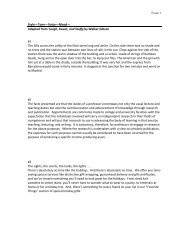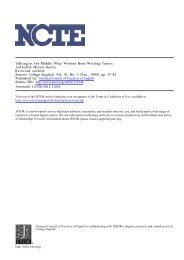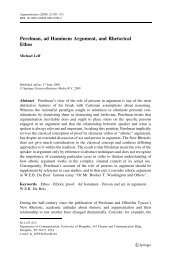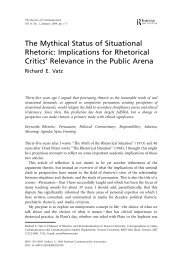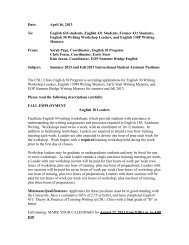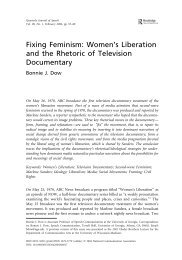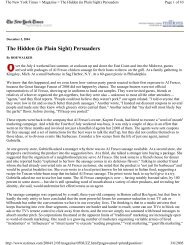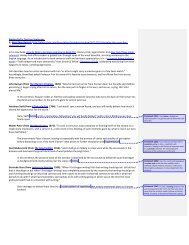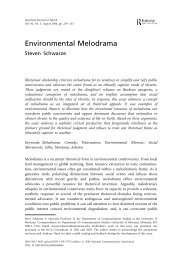Trimbur, “Peer Tutoring: A Contradiction in Terms?” - CompHacker
Trimbur, “Peer Tutoring: A Contradiction in Terms?” - CompHacker
Trimbur, “Peer Tutoring: A Contradiction in Terms?” - CompHacker
Create successful ePaper yourself
Turn your PDF publications into a flip-book with our unique Google optimized e-Paper software.
26 The Writ<strong>in</strong>g Cencer journalPeer <strong>Tutor<strong>in</strong>g</strong>: A <strong>Contradiction</strong> <strong>in</strong> Tcrms1 27played but as social pressures that converge on peer tutors, lead<strong>in</strong>g to theconflict of loyalty and identity crisis that <strong>in</strong>here <strong>in</strong> peer tutor<strong>in</strong>g. Tutortra<strong>in</strong><strong>in</strong>g, then, is not so much a matter of learn<strong>in</strong>g what roles to play as it is amatter of learn<strong>in</strong>g how to negotiate the conflict<strong>in</strong>g claims on the tutors'social allegiances.Tra<strong>in</strong><strong>in</strong>g and Tim<strong>in</strong>gThe two models of tutor tra<strong>in</strong><strong>in</strong>g-the apprentice model and the co~learner model-reproduce at the professional level the contradiction ofterms "peer" and "tutor" that students experience at a gut level. The tilt oftutor tra<strong>in</strong>ers toward either the peer or the tutor component of the equationcarries important implications not only for tutor tra<strong>in</strong><strong>in</strong>g but also for thedesign and function of peer tutor<strong>in</strong>g programs <strong>in</strong> writ<strong>in</strong>g centers. To followthe apprentice model and emphasize expertise and theory is to conceive ofpeer tutor<strong>in</strong>g as an arm of the writ<strong>in</strong>g program, a way to deliver state~of~the~art <strong>in</strong>struction <strong>in</strong> writ<strong>in</strong>g to tutees. To follow the co~learner model andemphasize collaboration and experiential learn<strong>in</strong>g is to conceive of peertutor<strong>in</strong>g as a semi~autonomous activity that contributes to the formation ofa student culture that takes writ<strong>in</strong>g seriously.I don't pretend these two models can be easily reconciled. It may be thecase, however, that the contradictory nature of the terms "peer" and"tutor" will make more sense if we stop talk<strong>in</strong>g about them <strong>in</strong> spatial terms,as roles to balance, and talk about them <strong>in</strong>stead as a temporal sequence to beplayed out. I want to suggest a rather messy solution to tutor tra<strong>in</strong><strong>in</strong>g that<strong>in</strong>corporates elements from both models but at different stages. What I have<strong>in</strong> m<strong>in</strong>d is a sequence of tutor tra<strong>in</strong><strong>in</strong>g that treats tutors differently depend~<strong>in</strong>g on their tutor<strong>in</strong>g experience-<strong>in</strong> short, that treats tutors develop~mentally. This developmental sequence would beg<strong>in</strong> with a Bruffeesqueapproach to the peer tutors as collaborative learners. Given the way thetraditional hierarchy <strong>in</strong>fluences new tutors' expectations and def<strong>in</strong>itions oftheir activity as tutors, they <strong>in</strong>itially need concrete and practical experienceco~ learn<strong>in</strong>g. Most peer tutors have had important experiences collaborat<strong>in</strong>g<strong>in</strong> everyday life but rarely <strong>in</strong> academic contexts. So they need practice if theyare go<strong>in</strong>g to be effective co~learners. To my m<strong>in</strong>d, this stage is the mostsignificant because it demands that students unlearn some of the values andbehaviors-the competitive <strong>in</strong>dividualism of traditional academics-thathave already rewarded them and shaped their identities as students. Theyneed, <strong>in</strong> effect, to rel<strong>in</strong>quish some of their dependence on faculty authorityand conventional measures of success (the source, we have just seen, of boththeir hopes and doubts as peer tutors) and to experience <strong>in</strong>stead the author~ity co~ learners <strong>in</strong>vest <strong>in</strong> each other as they forge a common language to solvethe problems writers face.Tutors need, that is, to develop confidence <strong>in</strong> their autonomous activityas co~learners, without the sanction of faculty lean<strong>in</strong>g over their shoulderand tell<strong>in</strong>g them and their tutees when someth<strong>in</strong>g is learned and when not.For most new tutors, the terms "peer" and "tutor" come together <strong>in</strong>mean<strong>in</strong>gful ways as tutors learn to work with their tutees, when togetherthey jo<strong>in</strong>tly control their purposes, set the agenda, and evaluate the resultsof their learn<strong>in</strong>g-as autonomous co~learners outside official academicchannels. It is this autonomous activity that creates the social space for peertutor<strong>in</strong>g and makes writ<strong>in</strong>g centers an extension of the social solidarity andcollaborative practices <strong>in</strong> student culture.To return to Kail's remark about how peer tutors teach us how to tra<strong>in</strong>them, I must admit that often new tutors want me to teach them how toteach. They expect me to tell them what to do, to tell them what messages tosend to their tutees, and to give them the methods to deliver these messages.But these questions are part of the old script, the script new tutors br<strong>in</strong>gwith them from their experience <strong>in</strong> the academic hierarchy of pass<strong>in</strong>g downknowledge. The <strong>in</strong>itial stage of tutor tra<strong>in</strong><strong>in</strong>g must address these expectationsbut <strong>in</strong>directly, by structur<strong>in</strong>g activities <strong>in</strong> which new tutors can ga<strong>in</strong>experience co~ learn<strong>in</strong>g. The po<strong>in</strong>t of tutor tra<strong>in</strong><strong>in</strong>g at this stage is to resocial~ize tutors as collaborative learners with<strong>in</strong> student culture. For this reason, Iagree with Bruffee that tutor tra<strong>in</strong><strong>in</strong>g must avoid produc<strong>in</strong>g "littleteachers." It's important to see, though, that the problem is not just thehalf~truth that a little knowledge can be a dangerous th<strong>in</strong>g. The problem isthat knowledge is a powerful th<strong>in</strong>g that aligns people with particular com~munities. To emphasize expertise <strong>in</strong> the <strong>in</strong>itial stages of tutor tra<strong>in</strong><strong>in</strong>g treatstutors as apprentices who are learn<strong>in</strong>g to jo<strong>in</strong> the community of professionalwrit<strong>in</strong>g teachers. I would argue that expertise <strong>in</strong> teach<strong>in</strong>g writ<strong>in</strong>g is not somuch dangerous as it is premature because it takes peer tutors out of studentculture, the social medium of co-learn<strong>in</strong>g.For me, tutor tra<strong>in</strong><strong>in</strong>g is a matter of tim<strong>in</strong>g and community allegiance.The apprentice model of tutor tra<strong>in</strong><strong>in</strong>g <strong>in</strong>vokes a k<strong>in</strong>d of knowledge-thetheory and practice of teach<strong>in</strong>g writ<strong>in</strong>g-that pulls tutors toward the professionalcommunity that generates and authorizes such knowledge. Instead ofimpart<strong>in</strong>g the professional expertise of the community of writ<strong>in</strong>g teachers,tutor tra<strong>in</strong>ers need to tap and organize the native expertise of co~learn<strong>in</strong>gthat is latent <strong>in</strong> the student's own community of undergraduates. What I'margu<strong>in</strong>g is that we need to resist the temptation to professionalize peer tutorsby treat<strong>in</strong>g them as apprentices and by design<strong>in</strong>g tra<strong>in</strong><strong>in</strong>g courses as <strong>in</strong>tro ~ductions to the field of teach<strong>in</strong>g writ<strong>in</strong>g. We need to treat peer tutors asstudents, not as paraprofessionals or preprofessionals, and to recognize thattheir community is not necessarily ours.



